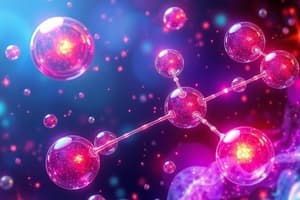Podcast
Questions and Answers
What are coordination complexes composed of?
What are coordination complexes composed of?
Coordination complexes consist of metal ions surrounded by ligands.
Why are transition states important in understanding chemical reactions?
Why are transition states important in understanding chemical reactions?
Transition states are high-energy intermediates that provide insights into reaction mechanisms.
How do coordination compounds facilitate catalytic processes?
How do coordination compounds facilitate catalytic processes?
Coordination compounds can serve as transition states for catalytic processes, lowering activation energy.
What role do metal complexes play in various applications?
What role do metal complexes play in various applications?
What is the main function of catalysts in chemical reactions?
What is the main function of catalysts in chemical reactions?
How do transition metal complexes contribute to catalysis?
How do transition metal complexes contribute to catalysis?
What role do ligands play in coordination chemistry?
What role do ligands play in coordination chemistry?
What factors influence the kinetics of coordination reactions?
What factors influence the kinetics of coordination reactions?
What are the functional groups found in ligands?
What are the functional groups found in ligands?
How does coordination chemistry contribute to the development of environmentally friendly processes?
How does coordination chemistry contribute to the development of environmentally friendly processes?
Flashcards are hidden until you start studying
Study Notes
Unlocking Chemical Dynamics and Coordination Chemistry
Coordination chemistry, the study of compounds where metal ions are bonded to organic or inorganic molecules called ligands, is a fascinating and versatile field. In this article, we'll explore the subtopics of metal complexes, transition states, catalysis, ligands, and reaction rates, all within the context of coordination chemistry.
Metal Complexes
Coordination complexes consist of metal ions surrounded by ligands, which form a coordination sphere that can influence the metal ion's electronic structure and reactivity. Metal complexes play crucial roles in various applications and processes, such as organic synthesis, materials science, and biochemistry.
Transition States
The study of transition states is critical to understanding the mechanism of chemical reactions. Transition states are high-energy intermediates formed during the course of a reaction, which, if stable, would have properties between those of reactants and products. Coordination compounds can serve as transition states for catalytic processes, facilitating the formation of products.
Catalysis
The use of coordination compounds as catalysts is a central aspect of coordination chemistry, driving industrial processes and organic synthesis. Catalysts lower the activation energy of reactions, increase reaction rates, and improve the selectivity of products. Transition metal complexes are particularly effective as catalysts due to their ability to undergo reversible changes in oxidation state and electronic configuration during the reaction process.
Ligands
Ligands play a pivotal role in coordination chemistry, directly influencing the properties and reactivity of metal complexes. The selection of appropriate ligands can enhance catalytic activity and selectivity, as well as the stability of metal complexes. Ligands can have various functional groups, including donor atoms such as oxygen, nitrogen, and sulfur, and can be classified as monodentate, bidentate, or multidentate.
Reaction Rates
Understanding reaction rates is critical to optimizing chemical processes. The kinetics of coordination reactions are influenced by several factors, including the geometry of the metal complex, the nature of the ligands, and the solvent. The study of coordination chemistry provides insights into reaction mechanisms and can lead to the development of more efficient catalysts and processes.
Emerging Trends
Coordination chemistry is an exciting field with numerous emerging trends. The application of coordination compounds in ultrafast processes, such as photocatalysis and solar energy conversion, is a particularly promising area of research. Green chemistry principles aim to minimize waste and pollution, and coordination chemistry plays an essential role in developing more environmentally friendly processes and materials.
In conclusion, coordination chemistry is a vibrant and diverse field with immense potential for advancing our understanding of chemical reactions, catalysis, and materials science. The study of metal complexes, transition states, catalysis, ligands, and reaction rates provides a deep insight into the mechanisms that govern chemical processes, paving the way for the development of more efficient and sustainable technologies.
Studying That Suits You
Use AI to generate personalized quizzes and flashcards to suit your learning preferences.




